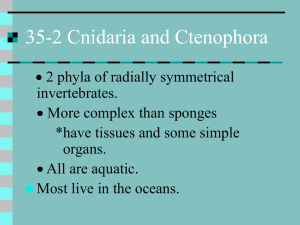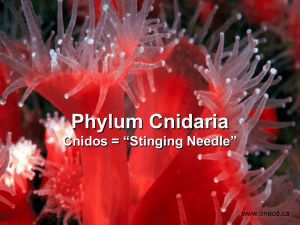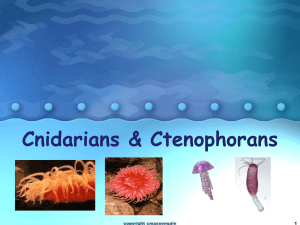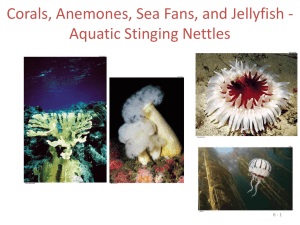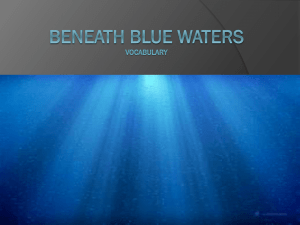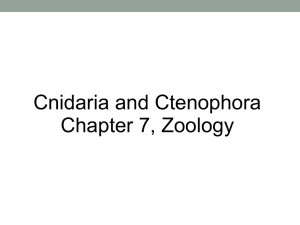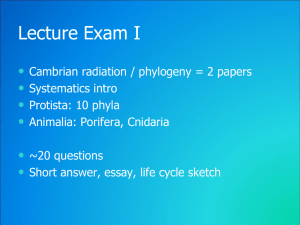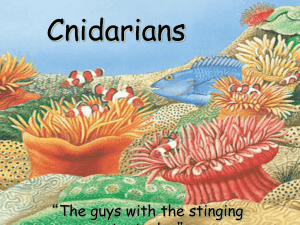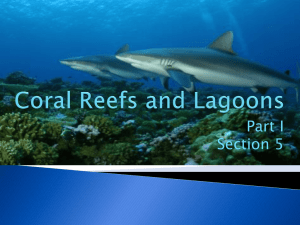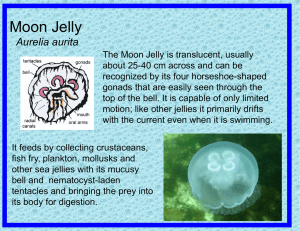2. Coelenterates
advertisement
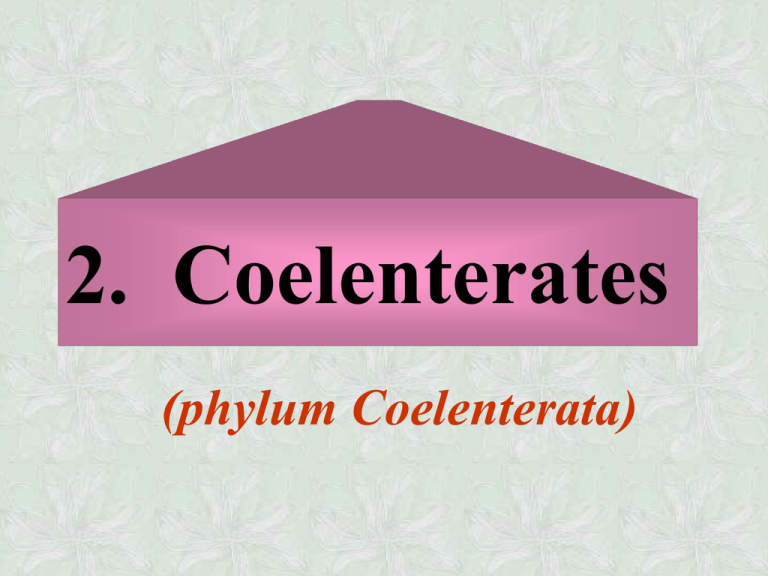
2. Coelenterates (phylum Coelenterata) The word coelenterate means “hollow body cavity”. All coelenterates contain a central cavity with only one opening . There are two general body forms found among the coelenterates. POLYP MEDUSA The Polyp form is usually sessile and has a cylindrical body with a mouth and tentacles at the upper free end. Corals and Hydras are examples Characteristics of coelenterates ; - The members of this group are jellyfish, sea anemones, corals and polyps . - The habitat of coelenterates is salt water but some of them live in fresh water. - They do not have a complete nervous system but they have nerve net . - Coelenterates have a sac like gut which serves as mouth and is surrounded by tentacles. - Their respiration method is similar to that of sponges. They respire only by means of diffusion across the cell membrane. - Although most coelenterates reproduce sexually, some of them reproduce by budding - Coelenterates have two definite tissue layers; an ectoderm and an endoderm. The structure of a hydra is a typical example of a coelenterate. It consists of a body wall within which is the gastro vascular cavity. A group of tentacles surrounds the mouth that opens into the cavity. The body wall of coelenterates has an outer layer (ectoderm), an inner layer (endoderm) and an intermediate layer, the mesoglia. The intermediate layer contains cells and jelly like substances. The gastro vascular cavity serves both as a circulatory and digestive system. It is surrounded by an inner layer of the body that is made up of secretory cells and columnar cells. These cells have the ability to engulf food particles. They are digested and then diffuse form the body. SUMMARY Coelenterates - Coelenterates have a central body cavity with one opening. -Most Coelenterates have stinging cells called nematocysts on their tentacles. Coelenterates sting and capture their prey, which they digest in the central body cavity. Waste products are released through the mouth. Coelenterates (Phylum Coelenterata) 1. Digestive cavity 2. Two life stages: attached polyps and free-swimming medusa 3. Tentacles with stinging cells 4. Radial symmetry 5. Nerve net 6. Aquatic organisms Hydra The hydra is a simple multicellular animal about 5 millimeters long from the tip of its tentacles to its base. The body of the hydra is a hollow cylinder made up of two layers of cells. 1. The outer layer is the ectoderm . The ectoderm is in direct contact with the aquatic environment 2. The inner layer is the endoderm. The endoderm lines the gastro vascular cavity. Hydra is in contact with water because water freely enters and leaves the gastro vascular cavity through the mouth endoderm tentacles ectoderm cnidoblast nematocytes The hydra captures its food with its tentacles. When a water flow or some other small animal comes in contact with a tentacle, the discharge their long threads. Some of the threads wind around the prey, nematocysts while others inject a poison that paralyzes the animal. By movements of the tentacles, the food is stuffed through the mouth and into the gastro vascular cavity , where digestion begins CORAL CORAL Corals Corals are small polyp that grow in colonies. Unlike hydras, they are surrounded by a hard skeleton Corals, like all coelenterates, are softbody organisms.but corals use minerals in the water to build a hard protective covering of limestone. Corals When the coral dies, the hard outer covering is left behind. Coral • The mouth of this coral is surrounded by tentacles. • What is the function of tentacles? Algae live inside the coral`s body. The algae help make food for the coral. Since algae need sunlight to make food , corals must live in shallow water where sunlight can reach them. This relationship between a coral animal and alga plant is among the most unusual in nature Coral, like all coelenterates, are soft-bodied organisms. But coral use minerals in the water to build a hard protective covering of limestone.When the coral dies, the hard outer covering is left behind. Sea Anemones Sea anemones look like underwater flowers. However, the “petals” are really tentacles, and their brilliant coloring helps attract passing fish. When a fish passes over the anemone`s stinging cells,the cells poison the fish. The tentacles then pull the fish into the anemone`s mouth, and the stunned prey soon is digested. The clownfish, however, is not harmed by the anemone.It is not affected by the anemone`s poison and swims safely through the anemone`s tentacles In this way, the clownfish is protected from other fish that might try to attack it. At the same time, the clownfish serve as a kind of living bait for the anemone. Other fish see the clownfish, come closer, and are trapped by the anemone. Jellyfish Jellyfish If you saw a jellylike cup floating in the water, recognize this coelenterate, the jellyfish. Although the jellyfish may look harmless, it can deliver a painful poison through its stinging cells. In fact, even when they are broken up into small pieces, the stinging cells remain active and can sting a passing swimmer who accidentally bumps into them. Like the other coelenterates , jellyfish use the stinging cells to capture prey Aurelia is a common jellyfish. Its life cycle includes both medusa and polyp forms.The jellylike body of the medusa is the form commonly seen on beaches. Protective tentacles hang from the edge of the umbrella-like body The sexes are separate in Aurelia, but the male and female look alike. Sperm from the male medusa are released into the surrounding water. Some sperm cells enter the gastro vascular cavity of a female medusa, where fertilization occurs. Early development occurs while the zygote is attached to the female. The zygote develops into a small, oval-shaped, ciliated larva called a planula. The planula is free swimming for some time.It then becomes attached by one end to a rock. The larva develops a mouth and tentacles at the unattached end and becomes a polyp. The polyp grows, eventually reproducing asexually to form medusa.This occurs in the fall and winter. The Reproductive Stages The medusa stage reproduces sexually by the production of egg and sperm, and it gives rise to the polyp stage. The polyp stage reproduces asexually by budding and give rise to the medusa stage. 1.Asexual Reproduction 2.Sexual reproduction Both type of reproduction, occur in the life cycle of any living things is called Alternation of generation Worms
